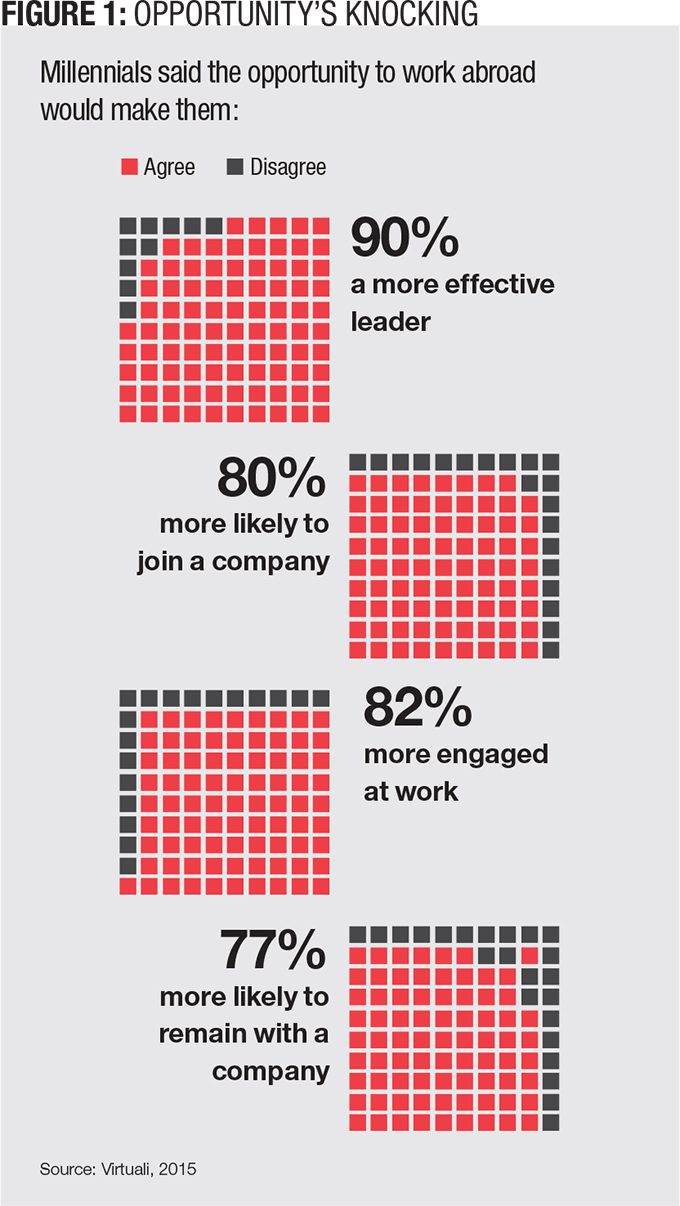In a global market, it is essential that company executives meet the growing demands of an international workplace. Leaders need to be equipped to navigate different languages and cultures, in addition to the traditional demands that come with leadership roles.
Yet most employees are not being trained for leadership roles until late in their careers. According to a study by leadership development consultancy Zenger Folkman, the average starting age is 42 for entrants in company-sponsored leadership development programs. Fewer than 10 percent of participants in these programs were under 30.

In a June 2014 Forbes article titled “The Urgent Need to Develop Global Leaders for Company Growth,” discussing the study, Zenger Folkman President and co-Founder Joseph Folkman said this statistic is unacceptable. The lack of early leadership development is one of the reasons why a third of global organizations identify “global leadership” as a serious constraint.
However advantageous it might be, starting leadership development earlier is easier said than done. Company-sponsored learning of any kind costs money, and determining which employees would be successful in global leadership roles takes time. Further, providing leadership development for young employees who haven’t yet proven their mettle can be seen as more of a gamble than an investment.
But even if an employee does not go on to fill an overseas role, global leadership development can still be worth investing in, said John Golding, a senior consultant at Development Dimensions International Inc. He said a leader doesn’t have to be in an expatriate assignment to work globally.
“It’s a key skill for any current and developing business leaders to be able to think as a global business person,” he said. “What we do here impacts our markets overseas, and all of those factors have to come into consideration. It’s valuable for leaders to be able to grasp that earlier rather than later.”
Leaders at Accenture realize they are a “global company operating in a global marketplace,” said Camille Mirshokrai, the company’s managing director of leadership development. For the management consulting and technology firm, building global leaders is a challenge of scaling leadership development to all 323,000 employees.
“We spend a disproportionate amount of our time and reinforcements making sure that our leaders know what is expected of them,” she said.
To do this efficiently, Accenture has invested heavily in digital learning. A major part of this strategy is the Leading at Accenture Platform, an intranet site that looks and feels a lot like social media.
“We no longer have to rely on having individuals sitting in seats in classrooms to learn,” Mirshokrai said. “Learning not only happens on the job; digital learning is available to our people on demand at all times.”
Digital learning also plays a major role in Qualcomm Inc.’s leadership development strategy.
The digital telecommunications company works with partners such as Harvard University and Stanford University to produce learning content in a mobile format so employees can access it readily.
“With the pace of the business, people are so busy, so our strategy has been to focus on bite-size mobile offerings and how we can get things to people right at the time of need,” said Jenny Tsoulos, a director of learning and development at Qualcomm.
“Right at the time of need” is another core element of how Qualcomm delivers leadership training. Tsoulos’ department works closely with human resources to ensure they are aware any time an employee is transitioning to a new position. An automatic email system alerts Tsoulos and her colleagues of the promotion, so they can in turn reach out to the employee to refer them to available resources.
Coaching Can Make Diversity Work
By Ram Ramanathan
We are all equipped with a unique attribute known as a mind map, a diagram of information organized by our mind. These maps are situationally aligned across several diversity factors including ethnicity, culture, age, gender, economic and social status and experience.
These variables unite as well as separate us from one another. Performance in work and life suffers when people do not manage these cultural diversity variables well. Three factors can help resolve diversity conflicts, as a coach and mentor:
- Address leaders who create conflicts to resolve conflicts.
- Emotional intelligence resolves conflicts.
- There are no sustained polarities in life, only commonalities.
What could a next generation, globally competent leader do? Consider the following five coaching competencies applied to leadership through diversity management:
- Establish clear positive goals to handle conflicts arising out of diversity issues.
- Engage with people to understand and empathize with their concerns to build trust.
- Communicate honestly and transparently, actively listening and asking the right questions.
- Create an awareness of obvious, underlying issues and what can be done to resolve them.
- Act decisively based on consistent creation of awareness.
These may seem simplistic, but as with all simple truths these can be profoundly effective.
The ability to manage diversity and create unity requires inspirational leadership that looks beyond oneself. Diversity is a state of mind created and nurtured by conditioning. Respect for the other helps reframe and dissolve related conflicts. Coaching delivers both.
But Qualcomm does not just wait until employees take on management roles to provide them with leadership development. For those not in the process of being promoted, the San Diego-based company offers an emerging leadership program that aspiring leaders can opt in to — this will prepare them if they show potential for or develop an interest in managing people.
This kind of programming is available to employees at all levels of the company, regardless of what stage they are at in their career. That means employees can begin leadership development at an early age.
“You don’t have to have worked at Qualcomm for a certain number of years in order to participate in any of our resources or solutions,” Tsoulos said. “We consider every employee to be a leader.”
The same applies at Accenture, where every employee has access to the Leading at Accenture Platform.
“This is one of the major investments we’ve made in the last two years in order to be able to scale leadership development to reach all our people, in all geographies, in all roles, around the world,” Mirshokrai said. “It gives them access to a variety of tools and helps us not make an investment one time in a group of people but be able to leverage our investment for a much wider audience.”
The Leading at Accenture Platform is tailored to each individual employee’s needs; that employee receives customized programming based on their profile. When workers log in to the platform, it curates and presents content based on who they are and where they are in their career.
“Rather than forcing individuals to navigate the many tools that are available, it curates and narrows that list to what is most useful and pertinent to me,” Mirshokrai said.
Not only does this individualization save time and energy by keeping users from endlessly scrolling through content irrelevant to their needs, but it also makes for more successful leadership development by catering specifically to an employee’s needs makes for more successful leadership development, said Richard Wellins, senior vice president at DDI.
“You have to think about what sorts of leadership development are good at what stages of a person’s career,” Wellins said. When it comes to global leadership training, he said the earlier the better.
To this end, DDI recently began offering a new course in partnership with Training Management Corp., a Berlitz company. The program, Leading with a Global Perspective, is designed to combine general leadership development with the skills and knowledge necessary to succeed in an international role.
“It’s taking some of DDI’s best leadership thinking and technology around developing leaders in general and marrying that to TMC Berlitz’s cultural skill-building and competence,” Golding said. “They’re very well known in the industry for being able to help people understand cultural differences, cultural preferences and being able to incorporate that into their own leadership.”
The course is based on a core set of skills DDI experts found to be necessary in any leadership role and how those skills translate globally.
“Regardless of where you operate in the world, those core skills will serve you well,” Golding said. “The difference is when you have to apply those core skills in a different cultural context. What works in the U.S. might look very different to what works in China.”
Leadership consulting firm OI Global Partners takes a similar approach. In addition to its standard assessment-based training, which determines which leadership areas participants need coaching in, the company employs a network of worldwide consultants to provide cultural training.
“Other regions might have a different working culture than here, so that’s why we need to have coaches from that part of the world,” said Tom Wharton, a board member of OI Global Partners.
When clients take on overseas assignments, OI Global Partners matches those clients with coaches from that part of the world who can provide the necessarily cultural development.
The same goes for clients who are not actually relocating but might be taking on a more global leadership role. “If they’re overseeing employees from three different countries, they have to be familiar with three different cultures,” Wharton said.
Similarly at Qualcomm, Tsoulos said employees transitioning into global roles are typically matched with a mentor familiar with the country where the job is located, whether that be someone within the company or an external coach.
“We really try and target their development individually,” Tsoulos said. “What’s your specific position overseas, what country will you be in, what are your roles and responsibilities? We try to tailor more individual development plans for those people.”
However, because Qualcomm rarely sends large groups of people overseas at one time, Tsoulos said as of right now, they are not offering any formal global development — so employees are exposed to cultural coaching through that mentorship program only after they have already been assigned to a global role.
Having himself been placed into an overseas position early in his career without much of a global leadership education, Golding said he believes making this sort of development more widely available would be hugely beneficial to the workforce as a whole.
“I worked for large global companies, and we had programs for teaching people like language prep and those kinds of things. But I know from personal experience having to work overseas what it’s like to not be prepared for some of the things I needed to think about,” Golding said, referring to his time abroad as an “eye-opening” experience. “I would have loved to have some of these tools.”
And in the context of what is, after all, an increasingly global market, those leadership tools are only going to become more relevant as time goes on.
“If we go deep enough in most organizations, we’ll find that we’re partnering with global suppliers, we’re partnering with customers who are global,” Golding said. “It’s a pretty key skill for folks to get in touch with sooner rather than later if they’re planning on a long leadership career.”















